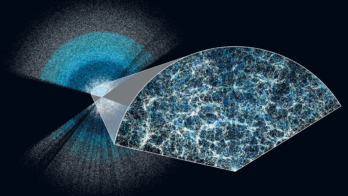
The Fermi Gamma-Ray Telescope can find out about more than gamma rays. It has now provided the most accurate measurement of the spectrum of cosmic-ray electrons and positrons. These results are consistent with a single power-law, but visually they suggest an excess emission from about 100 GeV to 1 TeV. The additional source of electrons and positrons could come from nearby pulsars or dark-matter annihilation.
The characterization of cosmic rays is undergoing some profound investigation. In addition to the ground-based Pierre Auger and Milagro observatories, balloon- and space-borne experiments are measuring the spectrum of electrons and positrons. Before 2008 this spectrum was only determined to within a factor of two or three, by balloon-borne experiments and by the Space Shuttle flight of the Alpha Magnetic Spectrometer (AMS) in 1998 (CERN Courier June 1999 p6). Recently, however, results of the Advanced Thin Ionization Calorimeter (ATIC) have had a huge impact. This balloon experiment flown above Antarctica suggested a strong excess of electrons and positrons at energies of 300–800 GeV. The spectrum obtained has a peak that is consistent with the annihilation of dark-matter particles with an energy of about 600 GeV (Chang et al. 2008). Then, earlier this year, the Payload for Antimatter Matter Exploration and Light-nuclei Astrophysics (PAMELA) space experiment found a clear excess of positrons over electrons at energies above 5 GeV (CERN Courier May 2009 p12).
The story continues to unfold with results from the Large Area Telescope (LAT) on board the Fermi mission (CERN Courier November 2008 p13). The LAT is sensitive to electromagnetic cascades generated inside the detector by either incoming gamma rays or by cosmic rays. Using only the first six months of data the Fermi collaboration obtained the most accurate measurement yet of the spectrum of electrons plus positrons in the 20 GeV to 1 TeV range (Abdo et al. 2009). The contamination of gamma rays in the electron/positron sample is estimated to be less than 2% and hadronic events could also be well discriminated against, such that the maximum systematic error remains below 20%, even at 1 TeV. The published spectrum is consistent with a simple power law when statistical and systematic errors are conservatively taken into account. The fitted power law falls with energy as E–3.0, which is slightly harder than the expectation from a conventional model of diffusive electron propagation in the Milky Way.
Visually, however, the Fermi data suggest a deviation from a simple power law above about 100 GeV. There is evidence for a bump at these energies, suggesting an additional component of primary electrons. The bump resembles the excess found by ATIC, but is much less pronounced. It can be put in parallel with the increased positron fraction derived by PAMELA, but the latter is at energies that are 10 times lower. Although inconsistent with each other, all three experiments suggest that there is an additional component of electrons and positrons towards higher energies. The origin of the excess could be dark-matter annihilation, but there are also alternative explanations, in particular the contribution of nearby pulsars. These possibilities are not discussed in the published paper but the collaboration foresees that Fermi will significantly improve the understanding of the electron spectrum in the coming months, in particular by searching for anisotropies in the arrival direction of the electrons.
Further reading
A A Abdo et al. 2009 Phys. Rev. Lett. 102 181101.
J Chang et al. 2008 Nature 456 362.





